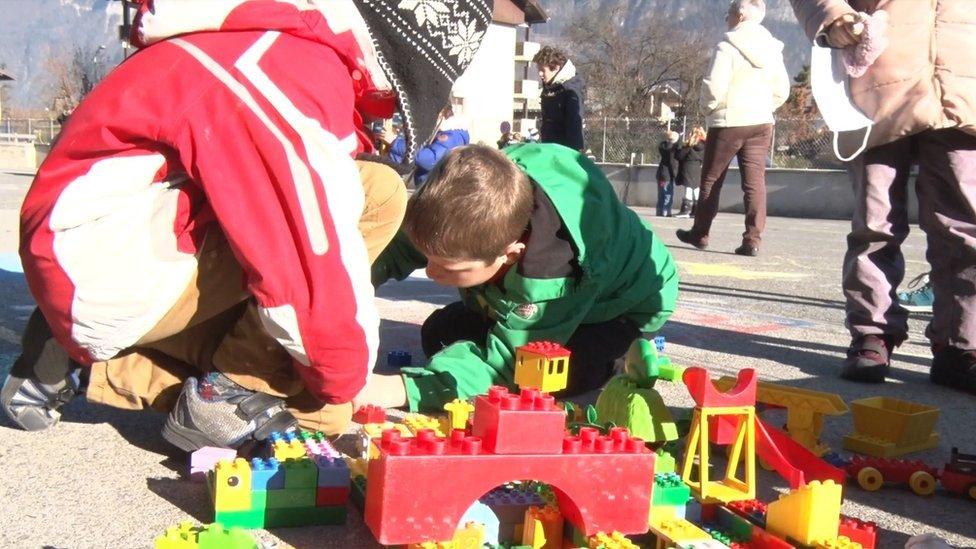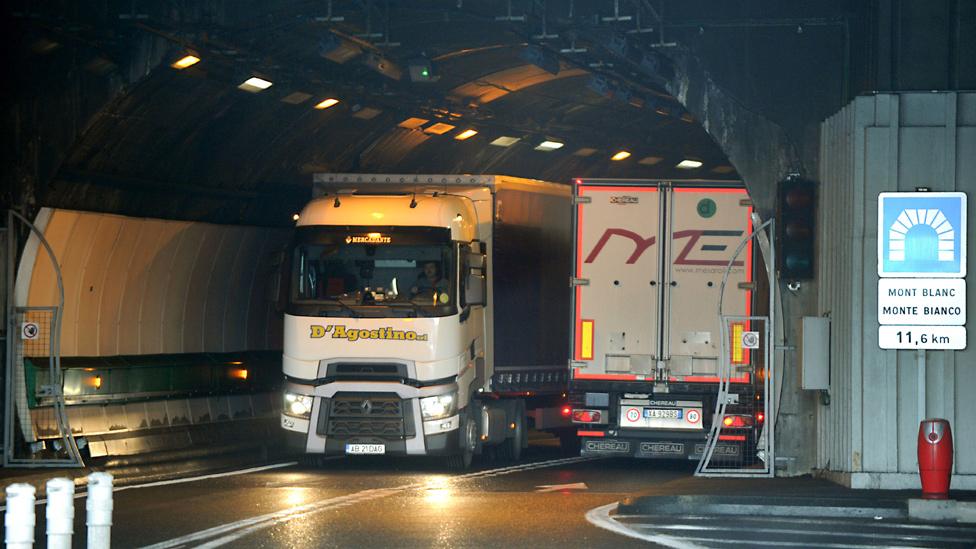Amazing views and dirty air in French Alps
- Published

French Alps: Few skiers are aware of the air pollution problem in some valleys
Camille Jouvenceau has an amazing view of Western Europe's highest mountain, Mont Blanc, from the balcony of her apartment in the pretty town of Sallanches. But the mountain air does not entice her.
"The air stinks outside, so you think twice about going out," she says.
She has had bronchitis, asthma and ear infections on and off since the end of November, when the fine particle pollution started peaking at red alert levels.
"Before you leave the house you ask yourself whether the air's going to make you cough or make your eyes stream or you have to spit," says Ms Jouvenceau, 24. "I leave earlier now when I go to work, so that I can walk slowly and of course I've stopped cycling or doing any sport."
It's like this every year in the 105km-long (65-mile) Arve Valley, home to 150,000 people and surrounded by some of the world's most famous ski resorts - Megeve, Saint Gervais and Chamonix.

Seasonal scourge
The pollution from fine (PM10) and ultra-fine (PM2.5) particles - the ones that get right down into your bronchial tubes and do the most damage - is now dangerously high for an average of 40 days a year.
In winter, this part of the Alps has the worst fine-particle pollution in France.

A cloud of dirty air hangs over Sallanches
The problem is compounded by the fact that, at the bottom of these deep mountain valleys, the air is often cooler than higher up. Since it is cooler, the air does not rise or disperse easily.
Prof Frank Kelly, chair of environmental health at King's College, London, says the mountains also block the wind, "rather like the mountains north of Beijing, which stop the dispersal of the wind-borne pollution from the south". He has been working with the French on a monitoring project in the Arve Valley.
At St Joseph's Infant and Primary School, the youngest children are kept inside at break time, while the older ones are allowed into the playground, but are not allowed to run around.

Children get less time to run around - so that they avoid taking big gulps of bad air
"Since the pollution alert started, the authorities have stopped all school sport," says head teacher Nathalie Gex.
"No skating, no swimming pool even. Our gym teacher's been giving theatre classes instead. At break time we give the older children chalk to draw on the ground, and cards and building blocks to play with, to make sure they don't move too much."
Wood-burning tradition
It's a beautiful day and I climb up above Sallanches - by car of course, I'm not going hiking in this air.
I was told you can see the pollution from up here. Well, you absolutely can. There is a thick, white quilt of it lying across the town.

Diesel fumes from Mont Blanc Tunnel lorries contribute to air pollution but are not the biggest cause
The other thing you can see from up the mountain is the main cause. Surprisingly, perhaps, it is not the lorries grinding up the valley towards the Mont Blanc Tunnel and Italy.
No, the main cause is a renewable energy source with an environmentally-friendly reputation - the humble wood-burning stove. Columns of smoke are rising from many of the houses.
"The latest surveys show that between 60% and 80% of fine-particle pollution here comes from wood-burning stoves and fireplaces in people's homes," says Vincent Hazout, who recently organised a demonstration calling for action against air pollution. It rallied 1,000 people in Sallanches.

Pretty villages create Alpine charm - but big volumes of wood smoke are harmful
Mr Hazout's six-year-old son is currently ill with asthma. When he was his son's age, he suffered from asthma too. His family lived in Paris but took the decision to leave because of young Vincent's health. They came to Alps for the "clean mountain air".
"Now we'll have to move too for my son, like my parents moved for me, unless we can solve this pollution problem," Mr Hazout says.

Pollution from wood-burning stoves tends to linger in the valleys
Clean-up campaign
The power to do something about the air in this valley lies mainly with the representative of central government, called the prefect.
His office, though declining an interview, provided details of all the anti-air pollution measures taken this winter - and there are quite a few of them: restrictions on the most-polluting heavy goods vehicles, a voluntary slow-down of some industrial activity, a decrease in volume of refuse-burning and a ban on burning wood for households with alternative means of heating.
"Clearly insufficient," says Mr Hazout. "The authorities don't want to implement more drastic measures, for fear of blackening the image of the ski resorts."

The pistes around Mont Blanc (left) are a magnet for skiers
So how are things up on the pistes?
In Chamonix, which attracts thousands of skiers each year, Mayor Eric Fournier says that on the slopes you are fine as you are above the danger zone, and that even in the town the pollution is not nearly as bad as it is down in the valley.
He also says air quality is actually improving in Chamonix, because of an upgrade scheme for wood-burning stoves, which he has put in place.
But the air quality in Chamonix on winter evenings is still poor. Plenty of wood smoke continues to pump fine particles into the air, despite this scheme.
For Vincent Hazout, the way forward is obvious. But it will take political will. Changing the way people heat their homes would have to become far more financially attractive or, if that failed, mandatory.
Prof Kelly agrees. "This pollution has three causes: the topography, the climate and the use of wood as heating fuel. We can't change the first two - although the Chinese have been experimenting with making rain to wash away pollution - but we can act on the wood-burning," he says.
In January 2015, the authorities in the Paris region banned the use of open fireplaces (more polluting than closed ones), before Ecology Minister Segolene Royal intervened to lift the order.
Many people in the French Alps hope that that measure, or an even more comprehensive ban on wood-heating, will be applied here.
"In two years," says Mr Hazout, "we could have this problem solved".

So I Can Breathe

A week of coverage by BBC News looking at ways to cut air pollution.
- Published7 December 2016

- Published2 May 2016

- Published1 June 2016

- Published24 July 2014
